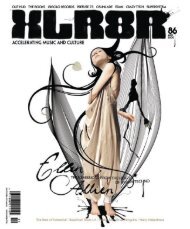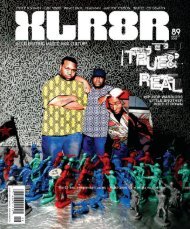Create successful ePaper yourself
Turn your PDF publications into a flip-book with our unique Google optimized e-Paper software.
“We took anything<br />
and made it feel like a<br />
rock guitar.”<br />
you’re not going to know where all the other things came from.<br />
Every record we made was a one-off. There is so much done in those<br />
records that we don’t even know where these things come from. If we put a<br />
kick drum onto a track it would be layered with two other kick drums so that<br />
it would create one sound. If we wanted to do a deep bass sound we might<br />
use the 808. Or we would make our own 808 and we would truncate the parts<br />
differently. We would take the attack off the 808 off the front and just use the<br />
sustain portion. We may take [the sound] off of a record and scratch it and<br />
then take the warping sound of it and trigger that inside. There was no one<br />
technique that we used on anything. You can never just sit there and go ‘Okay,<br />
I’m going to go pull up an SP1200 and pull up a stock sound of a kickdrum<br />
and a snare and I’ll get your sound.’ That’s not going to happen.<br />
– Hank Shocklee<br />
Jason Forrest: Obviously the Bomb Squad did something no one else really<br />
had done at the time when you first began producing. Why were you so<br />
interested in all this noise<br />
Hank Shocklee: We wanted to do something that we knew was going to wake<br />
up people. We wanted to alert them to a message that was frustrating us. We<br />
were calling it noise because nobody wanted to hear it–they didn’t want to<br />
hear our ideas, they didn’t want to hear our ideologies about music. So we<br />
bottled it as noise and threw it at them.<br />
I always like how Chuck’s MCing, this idea of a hard pill to swallow,<br />
matched up with this literal idea of noise–of a Prince guitar solo being fed<br />
back and looped so that it made this big slab of sound. How did you decide<br />
to choose this aesthetic<br />
Rhythm was a very big key with PE. I’m into harmonics from a dissonant point<br />
of view. I like the way harmonies work together, and I can also appreciate harmonies<br />
that don’t work together but they gel. PE was basically an experiment<br />
with sound. I wanted to make sure that the sound that we were doing matched<br />
the mood of what we were about. We were very angry about everything at<br />
the time–noise was something that was coined out of the aggressiveness that<br />
we were creating. If you go back through musical history, anything that was<br />
done that pushed the envelope was perceived as noise. Rock ‘n’ roll was noise.<br />
Classical music was noise. We came across with a new form of music–basically<br />
taking music that was already pre-recorded and pulling out the frequencies and<br />
sustaining them and stretching them and bending them and controlling them in<br />
a fashion that felt to us like rock ‘n’ roll. We took anything and made it feel like<br />
a rock guitar, whether it be a horn blast or a violin string pad.<br />
There’s so many small elements of other people’s music that do pop out and<br />
are recognizable in your music. I’ve mentioned Prince, the intro for “Fame”<br />
from David Bowie, Beatles bits. Why did you allow things to be recognizable<br />
Because that was the fun in it. It was the musical hook, if you would. If everything<br />
is unknown then it gets washed out. Some things have to have some<br />
context to it. So you could go, ‘Oh! I know where that part came from!’ but<br />
Another thing I was always so bewildered by initially and have come to cherish<br />
are the little cut-up parts between tracks.<br />
To make these records work was very detailed, it took a lot of time. We would<br />
do a lot of preliminary work before we would go into a studio. We’ve always<br />
wanted to make the sound as visual as possible. We were doing foley that cats<br />
would do in movies on albums. Say, for example, we wanted a speech that<br />
said things in a certain way but the speech only said half the phrase. We may<br />
go back in and recreate the way the speech was recorded using all the studio<br />
effects we have, then insert them in as samples so that those things became<br />
seamless. We would add in the hiss, we would add in the crackle–all of the<br />
things that made it appear like it was a sample.<br />
Now those are presets, but we created those things before all these companies<br />
even knew what the hell was going on. When you look at filtering, for example,<br />
that was a thing that we were doing because we stumbled across it. It was actually<br />
a defect in the original SB12 design. When you plugged in the plug into the<br />
mix out of a SB12, and the cord doesn’t go in all the way, it still makes a connection<br />
but it shaves off the high end; what was left was the bass portions of the<br />
sound. When we realized that we said ‘Oh wow, that’s a cool effect.’<br />
What did each member of the Bomb Squad do to make up the sound That<br />
part to me seems really mysterious.<br />
We all did everything. Besides me, Keith, Eric, and Chuck, there was Flavor<br />
Flav and Terminator X. Everything was divvied up to whoever was feeling<br />
what at that particular moment. If Eric felt like ‘I can add a little sequence<br />
part here’–it may just be a tambourine loop–then he would add that. If Flav<br />
feels like ‘I wanna add the timing to this little drum sample,’ he’s going to<br />
add that. Everything went through my control because I’m the one that’s<br />
overseeing the entire process. Nobody had a station, but what we did do is get<br />
down as a band. Eric might be on the drum pads, Keith might be on another<br />
set of drum pads, Chuck might be on a turntable, Flavor might grab a bass,<br />
Terminator was on a turntable, I might be on a keyboard sampler. And we’re<br />
all just jamming–just making a fucking mess–but we’re running tape. Every<br />
now and then you’ll get a moment that will be the most incredible five seconds<br />
and that little piece might end up being a part of a record.<br />
We did not sequence things. We wanted everything to have our feel. If you<br />
really listen closely, a lot of the timing on things is not correct and it’s not supposed<br />
to be correct. You can easily take a high hat, put it into a machine, quantize<br />
it at 16s, and let it run from beginning to end. That sounds very mechanical.<br />
You’re not going to get the loose feel of it. When we play it by hand, the<br />
high hats are at different lengths and different timing. When you start stacking<br />
those things, you’re getting a groove that’s being created from all the things<br />
that are a little bit off. The reason why most records made today are boring is<br />
because they’re linear. They begin and end doing the same patterns, the same<br />
spacing, the same timing. Records are supposed to be a living, breathing thing.<br />
Hank Shocklee<br />
Visit Hank Shocklee online at www.shockleeentertainment.com. Jason Forrest’s Shamelessly Exciting is<br />
Jason Forrest<br />
out October 4 on Sonig. www.sonig.de, www.cockrockdisco.com<br />
58 59











